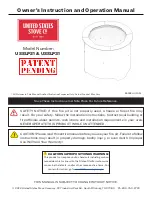
Page 37
DEFINITIONS
AIRTIGHT HEATER
—
In an airtight heater, all air enters in through inlets. Generally, non-airtight stoves are not
as efficient and their level of heat output is less controllable than that of an airtight.
BURN CYCLE
—
Time span between refueling in which wood is reduced to a bed of hot coals.
BYPASS
—
Movable door inside a woodstove that is opened when stove door is opened to give a path of least
resistance to smoke to prevent roll-out.
CREOSOTE
—
Condensed wood-gas vapor.
DOWNSTREAM TEMPERATURE
—
Outlet temperature of combustor or temperature of gas leaving
combustor from chimney side or face.
DRAFT
—
Amount of vacuum created by buoyant hot air in chimney. Draft pulls in oxygen for combustion
process and pulls out exhaust gases.
FIREBRICK
—
Brick capable of withstanding high temperatures. Used in furnaces, kilns and stoves. Used to
mean only “hard” or “dense” firebrick as distinguished from “soft” or “insulating” firebrick.
FIRING RATE
—
Rate at which fuel is burned in a heater.
FLAME IMPINGEMENT
–
Flames directly contacting combustor face.
FLUE COLLAR
—
The part of a stove to which chimney connector or chimney attaches.
GLOW-PLUG EFFECT
—
When a combustor is at temperatures above 1400
o
F (760
o
C) and periodically causes
pockets of wood gas in firebox to ignite spontaneously.
GREEN WOOD
—
Non-dried, freshly cut wood from a live tree.
IGNITION TEMPERATURE
—
The minimum temperature of a flammable mixture of gases at which it can
spontaneously ignite.
LIGHT-OFF
—
Activation temperature of combustor catalyst.
NOBLE-METAL CATALYST
—
A catalyst is a substance that can accelerate a chemical process without being
consumed by it. A noble-metal catalyst is one made of a precious metal or metals. (In the combustor, platinum and
palladium are used because they are stable under high heat conditions.)
Summary of Contents for MODEL 20
Page 2: ......
















































